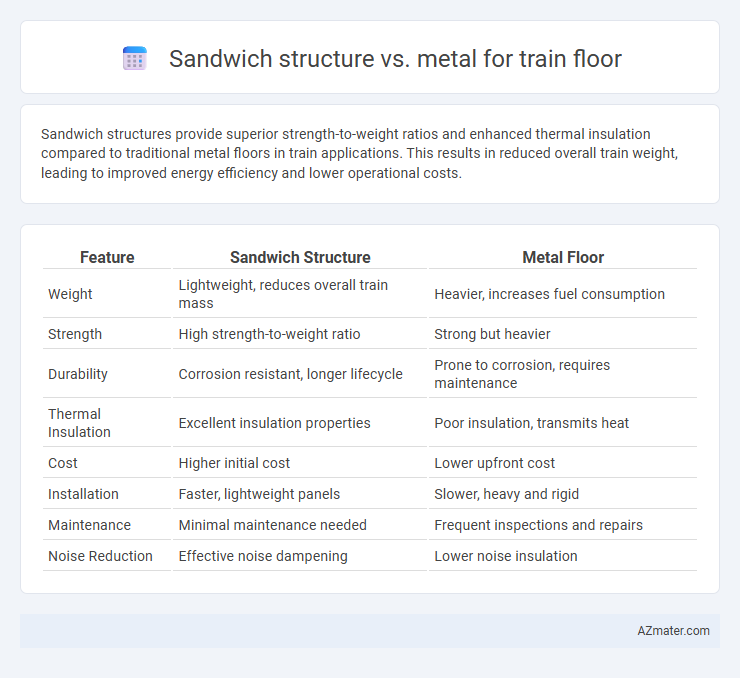Sandwich structures provide superior strength-to-weight ratios and enhanced thermal insulation compared to traditional metal floors in train applications. This results in reduced overall train weight, leading to improved energy efficiency and lower operational costs.
Table of Comparison
| Feature | Sandwich Structure | Metal Floor |
|---|---|---|
| Weight | Lightweight, reduces overall train mass | Heavier, increases fuel consumption |
| Strength | High strength-to-weight ratio | Strong but heavier |
| Durability | Corrosion resistant, longer lifecycle | Prone to corrosion, requires maintenance |
| Thermal Insulation | Excellent insulation properties | Poor insulation, transmits heat |
| Cost | Higher initial cost | Lower upfront cost |
| Installation | Faster, lightweight panels | Slower, heavy and rigid |
| Maintenance | Minimal maintenance needed | Frequent inspections and repairs |
| Noise Reduction | Effective noise dampening | Lower noise insulation |
Introduction to Train Floor Material Choices
Train floor material choices significantly impact durability, weight, and passenger safety, with sandwich structures and metals being prime options. Sandwich structures combine lightweight cores like foam or honeycomb with strong outer layers, offering superior strength-to-weight ratios and enhanced insulation. Metals such as aluminum and stainless steel provide high mechanical strength and durability but increase overall floor weight, affecting fuel efficiency and maintenance costs.
Overview of Sandwich Structures in Rail Applications
Sandwich structures in rail applications feature a lightweight core material, such as foam or honeycomb, bonded between metal or composite face sheets, offering enhanced strength-to-weight ratios compared to traditional metal floors. These structures improve energy absorption, thermal insulation, and vibration damping, contributing to passenger comfort and safety. Their corrosion resistance and reduced maintenance requirements make sandwich panels increasingly favored for modern train flooring systems.
Traditional Metal Floors in Train Design
Traditional metal floors in train design offer exceptional strength, durability, and high load-bearing capacity, making them suitable for heavy rail traffic and long-term use. Despite their robustness, metal floors tend to be heavier, contributing to increased overall train weight and reduced fuel efficiency. Maintenance requirements are higher due to susceptibility to corrosion and wear, which can increase lifecycle costs compared to modern alternatives like sandwich structures.
Weight Comparison: Sandwich Structure vs Metal
Sandwich structures used in train floors offer significant weight reduction compared to traditional metal flooring, often achieving up to 50% lighter components. The core materials, such as foam or honeycomb, combined with composite skins, provide a superior strength-to-weight ratio, enhancing fuel efficiency and reducing overall train mass. Metal floors, while durable, tend to be heavier and can increase energy consumption and wear on the train's suspension system.
Mechanical Strength and Durability
Sandwich structures, composed of lightweight cores bonded between metal or composite skins, offer superior mechanical strength-to-weight ratios compared to traditional metal floors, enhancing energy absorption and impact resistance in train applications. Their high stiffness and fatigue resistance contribute to improved durability under repetitive loading and vibration conditions typical in rail environments. Metals, while inherently strong and durable, generally result in heavier floors that may reduce fuel efficiency and increase wear on train components over time.
Fire and Thermal Performance
Sandwich structures for train floors offer superior fire resistance compared to traditional metal flooring, utilizing fire-retardant cores and composite skins that prevent rapid flame spread and reduce toxic smoke emissions. Thermal insulation properties in sandwich panels enhance passenger comfort by minimizing heat transfer and maintaining stable interior temperatures, unlike metal floors which conduct heat and cold more readily. Fire performance standards such as EN 45545-2 are more easily met by sandwich composites due to their low thermal conductivity and improved flame retardancy, making them a safer and more energy-efficient choice for rail applications.
Acoustic Insulation Properties
Sandwich structures for train floors offer superior acoustic insulation compared to traditional metal floors due to their multi-layer composition, which effectively dampens vibrations and reduces noise transmission. The core materials, such as foam or honeycomb, absorb sound energy, minimizing both airborne and structure-borne noise inside the train cabin. Metal floors, although durable, typically require additional insulation layers to achieve comparable acoustic performance, making sandwich panels a more efficient solution for noise control in rail applications.
Installation and Maintenance Considerations
Sandwich structure floors for trains offer lightweight advantages, leading to faster installation times and reduced labor costs compared to traditional metal floors, which require more extensive welding and fastening. Maintenance of sandwich floors is simplified by their corrosion-resistant core materials, decreasing the frequency of repairs, whereas metal floors often demand regular inspections and treatments to prevent rust and fatigue. The reduced downtime due to quicker repairs and easier component replacements makes sandwich structures more cost-effective for long-term train floor maintenance.
Cost Analysis: Initial and Lifecycle
Sandwich structures for train floors offer lower initial material and installation costs compared to traditional metal floors due to lightweight composite cores that reduce fabrication complexity. Lifecycle cost analysis reveals sandwich floors provide significant savings in maintenance and fuel consumption by improving energy efficiency and corrosion resistance, extending service intervals. Metal floors incur higher long-term expenses from frequent maintenance, corrosion prevention, and increased energy usage due to heavier weight, leading to elevated operational costs over the train's lifespan.
Future Trends in Train Floor Technology
The future of train floor technology increasingly favors sandwich structures due to their superior strength-to-weight ratio, enhanced thermal insulation, and improved energy efficiency compared to traditional metal floors. Advances in composite materials and manufacturing techniques are driving adoption of sandwich floors that reduce overall vehicle weight, leading to lower fuel consumption and increased speed capabilities. Research into sustainable, recyclable sandwich panel components also supports industry trends toward eco-friendly, durable train flooring solutions that meet stringent safety and performance standards.

Infographic: Sandwich structure vs Metal for Train floor
 azmater.com
azmater.com